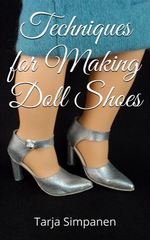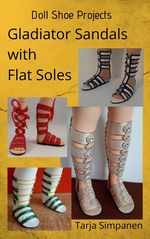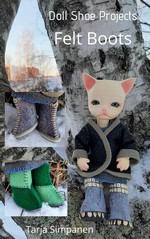Saturday, February 27, 2021
Last couple of weeks
Sunday, February 14, 2021
Got inspired by shadow quilting
I read about shadow quilting, and one of the teachers showed some of her work in the similar vein, so I wanted to try something like that. For the first attempt, I took a picture from a coloring book and recreated it using scraps of fabric. I used textile glue to attach the pieces from one or two places to stop them from getting misplaced before the stitching.
After finishing the picture, I covered it with tulle and stitched on top of it to get everything to stay in place and flat. Here you can see also the original picture. When it comes to copyrights, this is fine as long as I'm keeping the resulting picture myself.
This is how the reverse side looks after stitching. Here the whiskers are also in place (they're not in the picture above).
And here is the final picture, whiskers and all.
This was fun to make, and I have already started another one, which will also be a copy of an existing picture. After that, I think I'll start trying to create my own pictures and maybe also try using different kinds of fabrics. It would be nice to get some 3D effect in the pictures as well, so thicker fabrics in some places could be worth experimenting with.
Wednesday, February 10, 2021
Using the rest of the bag fabric
After making a basket out of the bag fabric, there was still some of it left. It was enough for making the smaller makeup bag, so that's what I decided to use it for.
The first photo shows the parts needed for it. There's one set for the outside and another for the lining.
First, I assembled the lining. There's some padding attached to the parts of the lining, but it's thinner than in the previous versions I've made.
The next stage was assembling the outside. The zipper goes to this one. I also did some additional stitching here that I didn't do in the previous ones. The fabric was so thick and stiff that it was best to stitch the seam allowances flat.
When both parts were ready, the last stage was to put the lining inside and stitch beside the zipper to attach the outside, zipper and lining to each other.
Here is a photo of the bag with the zipper closed. I'm planning to use this with the bag for all the small stuff I usually carry with me (meds, tissues, band-aids, etc.).
And there was still some fabric left. It took me a while to figure out what to do with it, but the pocket I made for the big tote bag gave me an idea. I used the rest of the fabric for making a cover for my small diary that I keep with me at school.
First I cut the pieces using the diary to get the measurements right. Then I sewed bias biding to the edges of the inside pieces and stitched the inside pieces in place (it's easier to do the bias binding when the pieces stay together).
Then I sewed bias binding all around the edges. I'm starting to love bias binding. You get so neat edges with it.
Here is the inside, with the diary in place. It's a really close fit. If the remaining piece of fabric had been even slightly smaller, the cover would have been too small.
This cover is so much nicer than the orange color in the diary covers. I bought it from a sale at half price and there were only orange ones left.
Sunday, February 7, 2021
More baskets
I have this shelf for which I've been looking for storage boxes of suitable size, but with no luck. After making those little baskets at school, I decided to modify the measurements of the pattern to suit the shelf and make some more of them. This is the result:
The red one is lower than the others, because of the measurements of the piece of fabric I had. I wanted the bottom of the basket to have the same size as in the others, so the sides had to be lower. It still works fine for the purpose.
The one with elephants is made of white fabric and only the front has pictures as I wanted to save most of that fabric for later use. The basket will be in the shelf most of the time, so the other sides won't show anyway.
The one with patterns was tricky, because there was no way to align the patterns. The fabric is from an old jacket and it was impossible to get pieces that could be aligned, so I decided to be content with aligning the types of stripes.
I've got another similar shelf in the living room, so I may end up making more of these later. These are so easy to make to fit the given space exactly. I wouldn't make these any bigger, though, or it would need to be from very stiff fabric. Even these are a bit floppy, but once you fill them with stuff (in this case, mostly fabrics), they will keep their shape quite nicely.
Saturday, February 6, 2021
Summary of week 5
Yesterday we collected everything we had made during the past couple of weeks on the big table at the back of the classroom. It was nice to see what others had been doing. Of course you see glimpses of other people's projects all the time, but as you're mostly concentrating on what you're doing yourself, you can't pay too much attention to them.
Here's my part of what was on display. I've already posted about the other things, but the little baskets on the back are new.
The first basket wasn't exactly a success. The fabrics fit nicely together, but the lining fabric was really slippery. The seams of the outside and the lining aren't aligned correctly, and the edge of the lining isn't straight. Still, it's not a total catastrophe, and after making it, I knew what I should be paying attention to.
The second one looks much better, although the lining looks a bit creased on the inside. It was probably too big, although I tried to cut the pieces accurately. The pattern for the basket is a cross formed of five squares. However, I had to make this from five separate pieces to get the pattern upright on all sides. There's still some of that bag fabric left even after this, so there will be at least one more item made of it at some point.
The last one is made of the felt I used for making felt boots for dolls (the projects for writing the latest book). I wanted to use the felt for something in which the surface of the felt would be left visible, and this was good item for experimenting. This basket is made of three pieces: one long strip and two squares. I didn't want to cut the cross shape out of the felt as the remaining felt would have had an awkward shape. It was left in a more usable shape after cutting it this way.
I used a big needle and thick red thread for the stitching as I wanted it to be as visible as possible. I also increased the stitch length quite a bit, because longer stitches look nice in something like this.
The main problem was that the bottom was convex after sewing the corners. That was solved by stitching the bottom edge as shown on the right in the photo above. The optimum way of making the basket using material like this would be to cut the material in cross shape and stitch all of the bottom edges in this way.
The photo below shows this basket in progress. It wasn't too hard sewing it, but you need to make sure that the edges are even and that you don't go too close to the edge, although you shouldn't go too far either.
The best thing of the week came around 4 PM on Friday. I got email from the study advisor. There are some theory courses that are common to all students, regardless of what vocation they're studying for. When you've got previous degrees and work experience, you can get some courses credited. I get to skip all courses in Finnish, English and Swedish as I've studied all of them quite extensively in the university and also worked as an English-Finnish translator for 25 years. I also got credit for the computer course I took in the open university.
There are a few courses for which I need to go and talk with the teacher and may get them credited, if they think I know enough about the subject. That leaves some courses the advisor said I have to attend, mainly mathematics, physics and chemistry. No surprises there, the last time I had anything to do with those was 30 years ago. I mean, not considering what you need in everyday life, such as calculating discounted prices, making a budget for yourself, knowing that the only thing you should add to chlorine is water, etc.
Thursday, February 4, 2021
Use for the swatches
I mentioned in an earlier post the 5 € batches of fabrics I got from Eurokangas. The latter one contained a set of swatches (in the middle below) with 32 different colors of the same fabric. I figured out what to do with them, so yesterday's project at school was that.
First stage was to cut the swatches to 15x15 cm size and overlock the upper and lower edges of each. Next, I arranged them to three strips of 8 pieces. Then I sewed the pieces of each strip together, ironed the seams, stitched on both sides of the seams, and used an overlocker for the vertical edges.
Then I sewed and stitched the vertical seams to get one big piece, and folded it in half and sewed the side seams.
Here's the other side.
I used a couple of the pieces for making an inside pocket. I used black bias binding as the top edge and handles would be made of black fabric.
The top edge wasn't quite finished as I took this photo, but you get the idea. This bag is for grocery shopping. It is tall and relatively narrow, which means it can accommodate a lot of stuff, but it is also easier to pack things in it so that they will stay upright and won't fall over.
Wednesday, February 3, 2021
The shoulder bag
I finished the shoulder bag yesterday. This time I took several in-progress photos. The first one is after cutting the main pieces needed for the bag. I used one of my existing bags as the starting point, and figuring out the needed pieces and the order of assembly took quite a bit of time. The fabric is called Art Deco Punos and it's sold by Kangaskeskus.
The very first thing I did was attaching one half of the buckle to the underside of the flap. That needs to be done first, so the stitches required won't show on top of the flap. Then I put the flap pieces together and sewed the bias binding to the flap edges. After that, I sewed the flap to the back pieces (two pieces, because the flap couldn't be attached to the top edge due to everything else that needed to be attached there).
There were some parts that had to be assembled separately. The first one was the zipper for closing the bag. The edges of this piece were later sewn to the upper edges of the front and back pieces.
Another separate piece was the inside pocket. This was what led the teacher to give us the exercise of sewing pockets. In the exercise, there was a separate pocket behind the zipper, but in this case there's just a small piece of fabric sewn on the right side, then cut open in the middle and turned to the reverse side to form neat edges for sewing the zipper.
Before the separate pieces could be sewn in place, the sides/bottom (one piece) had to be sewn to the back piece and then to the front piece. I stitched these seams, and the picture below shows the stitching of the latter seam in progress. This was probably the hardest part of the assembly, although not the most time-consuming.
The next photo shows the finished bag. After finishing the previous stage, I attached the other half of the buckle to the front piece, the inside pocket and the part with the zipper to the upper edge of the back piece, the other edge of the latter to the upper edge of the front piece, and the ends of the shoulder strap to the sides. The final stage was sewing bias binding to the upper edge.
Although the fabric is thick upholstery fabric, this bag isn't very sturdy, because it has just one layer of fabric in all other parts except the flap. I thought this was complicated enough for me at this point. I'll probably try making another one with added support at some point, but right now I'm just happy that I finished this.
My biggest gripe with this is the direction of the pattern in the shoulder strap. The strap is 126 cm long, and I had a 140x80 cm piece of the fabric, so I had no choice when cutting the strap. I would have preferred the same direction as in the flap and front, but at least it's the same direction as in the sides. And if the pattern of the strap was upright, the sides should have been separate pieces to get the pattern upright there as well. I wondered why the sides and bottom were separate pieces in the original bag, but maybe this is the reason, although that bag is green all over. It could be that they just used the same pattern as for a bag in which the direction of the fabric matters.
If this had been a mass production, there would have been no problem. The straps would have been cut in the right direction, several of them side by side, so no fabric would have been wasted. As it was a single piece made of relatively expensive fabric, compromises had to be made.
Tuesday, February 2, 2021
Some exercises
I finally remembered to take pictures of some of the exercises done last week. First one is pockets. And yes, there is a pocket on top of that checkered piece. It's not perfectly aligned, but well enough to make it hard to see the pocket right away. The other one was really an exercise in sewing a zipper. I needed one for the inside pocket in the bag I was planning, so the teacher decided to give us these exercises.
Then we learned how to sew corners as shown in the next picture. It's a good way to sew corners of small table cloths. It took a while to figure out how it is done, but it's not hard once you understand it.
The next exercise was sewing tote bags. I made two. In these, you needed to use at least three different fabrics and sew a pocket on the outside. The green one is the first one I made, and it's bigger, because I made a calculation error and the middle stripe is too high. The other one is really a mixed bag, because I first took the piece with blue stripes and then I had to find fabrics of the same thickness. I kind of like the result, though.
Here's a picture of both bags from the other side.
I have also finished the shoulder bag I mentioned earlier, but that deserves a blog post of its own, so I'll tell about that later.












































